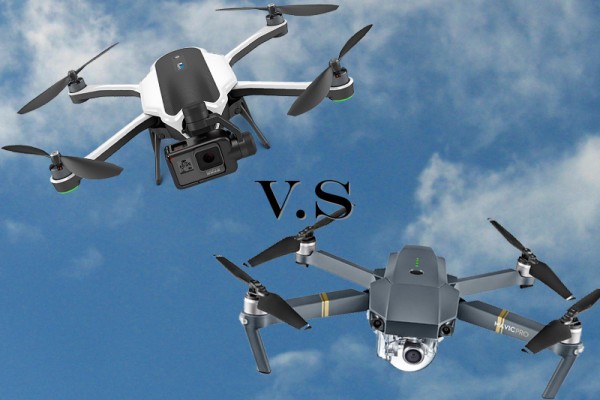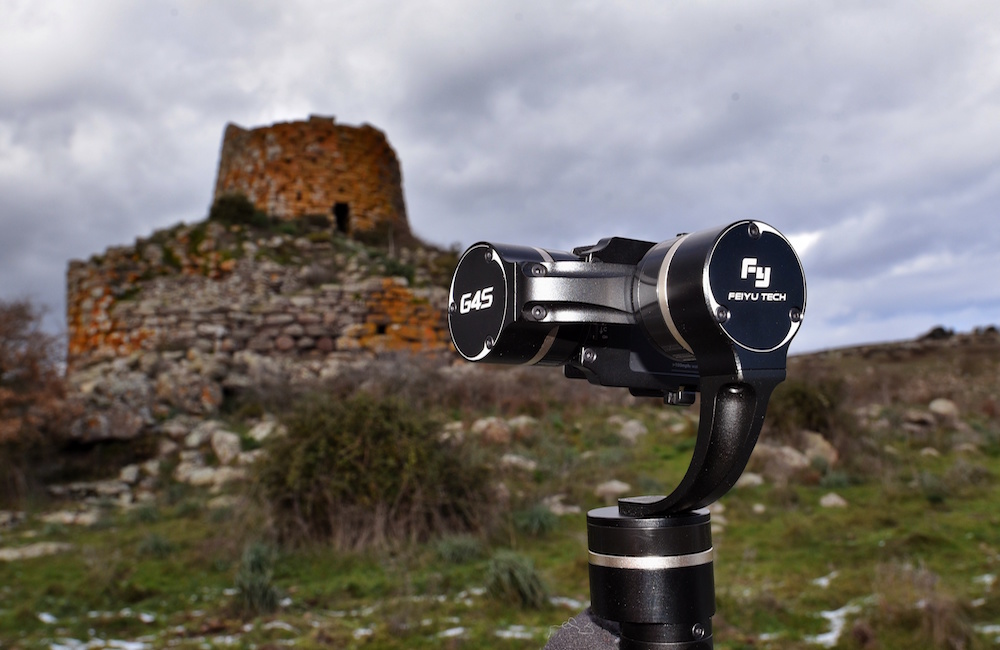Last week we jumped around the office in excitement about the new GoPro Karma portable drone – that was until the makers of the World’s best selling drone company DJI released details of their portable foldable drone version, Mavic Pro one week later.
The big selling point for both the Mavic and Karma is size. Both utilise a brilliant foldable design to be more portable when you aren’t flying – for travel/adventurers, it’s their prays answered. The Mavic is lighter and folds up more compact. It can fit inside of a purse or holster on your belt, whereas the Karma fits comfortably inside of a backpack. You could fit 2 or 3 Mavics inside of the backpack that holds the Karma. That doesn’t mean the Karma is too big. It’s still much smaller and lighter than traditional drones.
So how do the two foldable drones stack up against each other on paper based on specs? From what we’ve read and the videos we’ve watched, here’s which drone we think wins on specs alone – these opinions are our own and based on the specs we’ve seen…until we can get our hands on them.
Speed
DJI Mavic Pro Wins
The DJI Mavic Pro has a faster top speed of 40 mph versus GoPro Karma at 35 mph.
Battery Life
DJI Mavic Pro Wins
The DJI Mavic Pro has a longer battery life at 27 minutes versus GoPro Karma at 20 minutes. It can even be outfitted with any phone or tablet you want. The Mavic Pro is also small enough to fit uncomfortably into a pair of jean pockets. The Karma, on the other hand, requires a backpack (or similarly-sized vessel) to be transported from place to place.
Not only does Mavic have a longer flight time, but it can also be operated up to 4.3 miles away, which gives it a huge advantage over the Karma.
Controller
DJI Mavic Pro Wins
The GoPro Karma ships with a controller using a built-in display and packs up nicely into the little backpack that comes with the Karma. The Mavic Pro has an optional controller, meaning you can instead operate the device from your phone. The controller that DJI sells separately can be paired with any phone if you want to see preview video while you’re flying.
Avoidance System
DJI Mavic Pro Wins
DJI Mavic Pro comes with five-camera obstacle avoidance system similar to the one in the Phantom 4. The GoPro Karma doesn’t have any obstacle avoidance features.
Follow Me
DJI Mavic Pro Wins
DJI Mavic Pro also comes with some cool follow modes – the drone can lead you in front, follow you at a profile and do a cool trick where it files circles around you as you move. The smart flying capabilities are enabled by the cameras and sensors on the drone. It’s still unclear whether the GoPro Karma will offer a follow me function.
Camera
GoPro Karma Wins Only Just
GoPro is known for making great cameras, but the Mavic manages to get the slight edge here too. The best configuration of the Karma uses the new Hero5 Black camera, which can shoot 4K video at 30 fps. The Mavic has a built-in camera that can shoot Cinema 4K at 24 fps. Cinema 4K has even higher resolution than standard 4K. Of course, the Mavic can do regular 4K at 30 fps too. The higher resolution doesn’t automatically give the Mavic a win, but previous DJI drones have produced excellent results.
The DJI Mavic Pro ships with a camera that shoots 4K video, but it’s bolted to the drone, so you can’t exactly use it while you’re not flying the drone around.
The GoPro Karma was built to combat these type of situations. It can be outfitted with the new GoPro Hero 5 Black, the Hero 5 Session, Hero 4, and Hero 3 cameras. If you already own one of theses cameras, the Karma is a great way to get them airborne, but if you still need to buy one, it could just make the cost of your aerial rig a lot more expensive.
Handheld Stabiliser
GoPro Karma Wins
Another cool feature of the GoPro Karma is its removable stabiliser that can be used as a handheld gimbal for shooting nice clean shots on or off the drone. When it comes to versatility of video recording, the GoPro Karma easily beats DJI.
Price
It’s close between the two drones – DJI Mavic Pro edges it slightly for us
The DJI Mavic Pro sells for $750 (approx £580) without the remote control (which means you’d have to use your phone or tablet to control it)
$1,000 (approx £770) with the controller.
The GoPro Karma sells for a flat price of $800 (approx £620) and comes with a controller that uses a built-in display.
The total cost depends on what camera you strap to it.
$1000 (approx £770) with a GoPro Hero 5 Session
$1100 (approx £850) with a GoPro Hero 5 Black.
When it comes to drones and budgets, there’s not a one-size-fits-all situation, so the perfect foldable drone will be a matter of preference. Without spending too much time flying either drone, though, it looks like the DJI Mavic has a slight edge in terms of performance and value. The GoPro Karma looks like the better value for money option for shooters, with a removable camera and gimbal that can be used for other application.
Comparison Table
Here’s a useful comparison table comparing the specs between the DJI Mavic Pro and GoPro Karma drones.
| SPEC | GOPRO KARMA | DJI MAVIC PRO |
|---|---|---|
| Built-in Camera | ✕ | ✓ |
| Handheld Gimbal Included | ✓ | ✕ |
| Dual IMU & Compass | ✕ | ✓ |
| Object Tracking | ✕ | ✓ |
| Obstacle Sensing System | ✕ | ✓ |
| Vision Positioning System | ✕ | ✓ |
| Precision Landing | ✕ | ✓ |
| Dual Operator | ✓ GoPro Passenger™ App | ✕ |
| Case / Backpack | ✓ | Optional Extra |
| Monitor / Screen included | ✓ (Touchscreen) | ✕ (LED info display only) |
| Smart Phone as Monitor | ✕ | ✓ |
| Gimbal | 3 Axis | 3 Axis |
| Camera Sensor | 1/2.3” (CMOS) | 1/2.3” (CMOS) |
| Camera Lens | FOV 94° 17.2mm f/2.8 | FOV 78.8° 28 mm f/2.2 |
| Resolution : UHD | 4K up to 30p / 2.7k 60p | 4K / 2.7k up to 30p + C4K 24p |
| Resolution : FHD | 1080 up to 120p | 1080 up to 96p |
| Resolution : HD | 720 up to 240p | 720 up to 120p |
| LOG Profile | ProTune™ | D-Log / D-Cinelike |
| Bitrate | 60 Mb/s | 60 Mb/s |
| Stills | 12MP RAW + WDR | 12MP DNG RAW + HDR |
| Burst shooting | 3/5/10/30 fps | 3/5/7 fps |
| Timelapse | 0.5s–60s | 10s–60s (assumed) |
| Max. Speed | 35 mph (15.6 m/s) | 40 mph (17.8 m/s) |
| Max. Distance | 1000m / 1km | 13000m / 13km |
| Max. Altitude | 4500m / 4.5km | 5000m / 5km |
| Max. Wind Resistance | 22mph (9.8 m/s) | 24mph (10.7 m/s) |
| Satellite Positioning | GPS | GPS + GLONASS |
| Transmission | Wi-Fi | Wi-Fi / OcuSync |
| Transmission Range | 1000m / 1km (assumed) | Up to 7000m / 7km |
| Operating Frequency | 2.4GHz | 2.4 GHz to 2.483 GHz |
| Downlink Stream | 720p HD | Up to 1080p FHD |
| Battery | 14.8v / 5100mAH | 11.4v / 3830 mAh |
| Flight Time (apx.) | 20 mins | 27 mins |
| Operating Temp. | ? | 32° to 104° F (0° to 40° C) |
| Weight | 1006g | 734g |
| Dimensions (open) in mm | L: 303 / W: 411 / H: 117 | ? |
| Dimensions (folded) in mm | L: 365 / W: 224 / H: 90 | L: 198 / W: 83 / H: 81 |
| Retail Price : US | $1099.99 inc. Hero 5 -or- $799.991 | $999.00 |
| Retail Price : UK | £999.99 inc. Hero 5 -or- £719.991 | £999.00 |
| Retail Price : EU | €1199.99(?) inc. Hero 5 -or- €869.991 | €1199.00 |
| Battery Price | $99.99 / £89.99 / €109.00 | $89.00 / £85.00 / €99.00 |
| Pre-order | ✕ Not yet | ✓ 27th Sept 2016 |
| Shipping | October 23rd 2016 | October 15th 2016 |
Head to Head Test Flight
Both companies pack a lot of features into the respective drones, the Mavic definitely has more features built-in and the automation is great for regular users out for fun. Karma may have the edge for filmmakers if the dual operator function works well.
We wait to see someone physically get these two drones and do some true head-to-head test flights in order to determine which is the best. Ahead of that head-to-head battle, it looks like the DJI Mavic Pro has the slight edge over the GoPro Karma, at least on paper.





